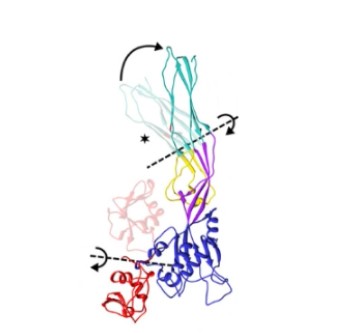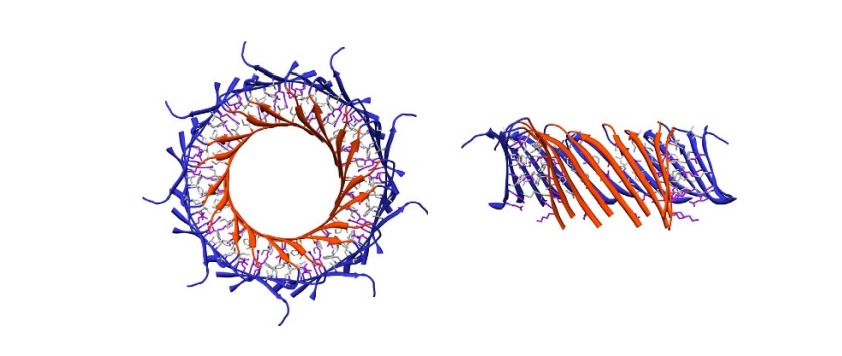User:Davi de Souza/Sandbox 1
From Proteopedia
| Line 19: | Line 19: | ||
When the CTP is cleaved from the main body of the protein, the proaerolisin oligomerizes into a heptameric ring on the target cell membrane, forming a pore. During proaerolisin oligomerization, domain 1 undergoes rotation, allowing all receptor binding sites to position themselves correctly relative to the target membrane. Domains 2 and 3 remain largely unchanged. On the other hand, domain 4, after cleavage of the CTP propeptide, undergoes rearrangement of the beta sheets, forming a beta sandwich. In the core of this sandwich, hydrophobic residues are internalized. Additionally, domain 4 rotates relative to domain 3, enabling hydrogen bonding between the beta sandwiches of two monomers, promoting the oligomerization of aerolysin.<ref>PMID: 27405240</ref> | When the CTP is cleaved from the main body of the protein, the proaerolisin oligomerizes into a heptameric ring on the target cell membrane, forming a pore. During proaerolisin oligomerization, domain 1 undergoes rotation, allowing all receptor binding sites to position themselves correctly relative to the target membrane. Domains 2 and 3 remain largely unchanged. On the other hand, domain 4, after cleavage of the CTP propeptide, undergoes rearrangement of the beta sheets, forming a beta sandwich. In the core of this sandwich, hydrophobic residues are internalized. Additionally, domain 4 rotates relative to domain 3, enabling hydrogen bonding between the beta sandwiches of two monomers, promoting the oligomerization of aerolysin.<ref>PMID: 27405240</ref> | ||
| + | [[Image:Torção 2.jpg]] | ||
The oligomerization of aerolysin, resulting from the circular association of the beta barrels from the seven monomers, forms a <scene name='97/973994/Oligomer_sanduich_beta/1'>hollow cylindrical structure</scene> (in the image, each color represents the domain 4 of a monomer, forming a tube). It is interesting to note that the beta sheets present in the cylinder are anti-parallel. | The oligomerization of aerolysin, resulting from the circular association of the beta barrels from the seven monomers, forms a <scene name='97/973994/Oligomer_sanduich_beta/1'>hollow cylindrical structure</scene> (in the image, each color represents the domain 4 of a monomer, forming a tube). It is interesting to note that the beta sheets present in the cylinder are anti-parallel. | ||
Revision as of 01:56, 26 June 2023
Aerolysin
General Aspects and function
Aerolysin is a toxin synthesized by some species of bacteria belonging to the genus Aeromonas, such as Aeromonas hydrophila. The exact function of Aerolysin may vary among different species and strains of Aeromonas. However, it is evident that it is the main macromolecule responsible for the pathogenicity of Aeromonas hydrophila, being associated with diarrheal diseases and deep wound infections [1]. About the structure of the protein, it is known that the toxin is setted up in an oligomeric structure with the activated forms of the monomers called proaerolysin.
Aerolysin plays several roles in the pathogenicity of Aeromonas spp. One of its main functions is its ability to promote lysis (rupture) of host cells, such as epithelial cells and immune cells. Aerolysin exhibits cytotoxic activity, causing damage to the cell membranes of host cells, which can lead to cell death and contribute to the bacterium's pathogenicity. Furthermore, aerolysin may be involved in the invasion and dissemination of the bacterium within the host. It can assist in tissue degradation, facilitating the bacterium's invasion into different organs and tissues of the host. It is important to note that the exact function of aerolysin may vary among different species and strains of Aeromonas. Additionally, there are other proteins and virulence factors produced by Aeromonas spp. that also play important roles in the pathogenicity of these bacteria.
| |||||||||||
Biotechnological applications of aerolysin
In addition to its biological importance, aerolysin has also sparked interest in the field of nanotechnology due to its potential as a sensor in nanopore sequencing. In this technique, a nucleic acid molecule is passed through a nanopore, and individual nucleotide bases are detected and identified through characteristic changes in the electrical or ionic signal generated during the translocation. By observing the nature of aerolysin pores, some scientists have begun to explore the use of aerolysin pores in sequencing. Several aerolysin mutants used in nanopore sequencing have shown promising results, demonstrating excellent sensitivity, selectivity, and stability. [4]
References
- ↑ Altwegg M, Geiss HK. Aeromonas as a human pathogen. Crit Rev Microbiol. 1989;16(4):253-86. PMID:2649316 doi:10.3109/10408418909105478
- ↑ Parker MW, Buckley JT, Postma JP, Tucker AD, Leonard K, Pattus F, Tsernoglou D. Structure of the Aeromonas toxin proaerolysin in its water-soluble and membrane-channel states. Nature. 1994 Jan 20;367(6460):292-5. PMID:7510043 doi:http://dx.doi.org/10.1038/367292a0
- ↑ Iacovache I, De Carlo S, Cirauqui N, Dal Peraro M, van der Goot FG, Zuber B. Cryo-EM structure of aerolysin variants reveals a novel protein fold and the pore-formation process. Nat Commun. 2016 Jul 13;7:12062. doi: 10.1038/ncomms12062. PMID:27405240 doi:http://dx.doi.org/10.1038/ncomms12062
- ↑ Wang Y, Gu LQ, Tian K. The aerolysin nanopore: from peptidomic to genomic applications. Nanoscale. 2018 Aug 7;10(29):13857-13866. PMID:29998253 doi:10.1039/c8nr04255a



